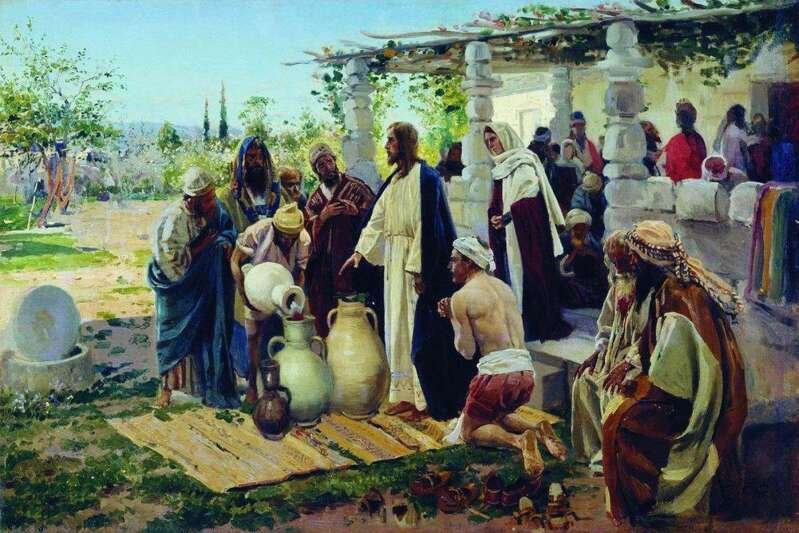The Miraculous Transformation: Where Jesus Turned Water into Wine

Miracle of Water into Wine
Introduction to the Miracle of Water into Wine
The biblical account of Jesus turning water into wine represents a pivotal moment in Christian teachings, marking the first miracle attributed to Him. This momentous event is recorded in the Gospel of John (2:1-11), where it occurred during a wedding feast in Cana, a town traditionally associated with the region of Galilee. This narrative not only underscores Jesus’ divine authority but also sets the stage for understanding His mission during His earthly ministry.
The transformation of water into wine serves as a profound symbol within Christianity, embodying themes of joy, abundance, and the sanctity of marriage. This miracle is particularly significant because it illustrates Jesus’ compassionate nature; He intervened to enhance the joy of the celebration when the wedding hosts found themselves in a predicament due to a shortage of wine. Through this act, He demonstrated His willingness to bless ordinary events and elevate them into moments of divine significance.
The Biblical Account: What Scripture Says
The miraculous transformation of water into wine, a significant event in the life of Jesus, is narrated in the Gospel of John, specifically in John 2:1-11. This passage describes a wedding in the town of Cana, where Jesus, his mother Mary, and his disciples were in attendance. The context of the event is important, as weddings during this time were not only crucial social occasions but also a reflection of the familial and communal bonds within Jewish culture.
As the celebration progressed, a problem arose: the hosts ran out of wine, which could lead to considerable embarrassment for the family. Mary, noticing this unfortunate situation, approached Jesus, indicating the need for intervention by stating, “They have no more wine” (John 2:3). It is here that the interaction between Mary and Jesus becomes pivotal. Initially, Jesus responds, “Woman, why do you involve me? My hour has not yet come” (John 2:4), which suggests a hesitance tied to his divine mission and timing.
This miracle is significant as it marks the first of Jesus’ signs, revealing his divine authority and foreshadowing the transformative power of faith in his ministry. It serves not only as a demonstration of his miraculous capabilities but also as an indication of the joy and abundance that accompanies a relationship with the divine.
Historical and Archaeological Insights
The event of Jesus turning water into wine at a wedding in Cana is one of the most significant miracles documented in the New Testament. Historically, this incident has intrigued scholars and researchers who seek to locate the precise geographical site of Cana. Many believe that understanding its location could illuminate aspects of first-century Jewish culture, religious practices, and the life of Jesus. Several theories have emerged regarding the identification of this biblical site.
One prominent candidate is the modern village of Kfar Kana, situated in northern Israel. Archaeological excavations in this area have unearthed artifacts that date back to the time of the Second Temple, suggesting that it could have been a thriving settlement during the period described in the Gospels. An inscription found near Kfar Kana references a wedding, which further lends credibility to this site as a possible location for the biblical event.
However, other scholars propose that Cana might be located near the ancient site of Khirbet Qana, situated slightly to the east. Excavations here have revealed remains of a significant settlement, supporting the notion of an established community during Jesus’ time. Furthermore, some archaeological findings, including pottery shards and structures, have been linked to wedding feasts, aligning with the miracle narrative. The debate over this identification continues, with many researchers specifically examining ancient texts to provide contextual evidence for the location.
Ultimately, while these historical and archaeological insights do not definitively pinpoint the site of the wedding at Cana, they contribute to a vibrant discourse surrounding the event. As new discoveries emerge, the quest to unearth tangible links to this miraculous transformation remains an ongoing exploration in biblical archaeology, further enriching our understanding of its historical significance.
Recent Discoveries: Experts Pinpointing the Location
Recent investigations by a group of archaeologists and biblical scholars have converged on a site in the region of Galilee, believed to be the biblical location where Jesus performed the miracle of turning water into wine. This extensive research builds upon earlier findings and combines a range of scientific methodologies, including archaeological surveys, historical texts, and geographical analyses, to substantiate these claims. The site, located near the small village of Cana, has been of considerable interest since ancient times, particularly among those who seek to connect physical locations with biblical narratives.
Utilizing various archaeological techniques, experts excavated the area, revealing ancient pottery shards, remnants of wine jars, and other pertinent artifacts dating back to the first century CE. These discoveries lend credibility to the assertions that the location was once a flourishing hub for winemaking, aligning with the biblical account of the miracle described in the Gospel of John. Furthermore, researchers employed ground-penetrating radar to examine subsurface structures, potentially identifying remnants of ancient dwellings or religious facilities that may have played a role in the events depicted in the scripture.
In addition to physical evidence, experts have meticulously analyzed historical texts, cross-referencing biblical references with earlier writings from historians such as Josephus. These textual analyses aimed to determine the historical accuracy of the location in relation to the miracle. The concordance of physical and textual evidence has provided a rigorous foundation for the claims put forward by the research team. As these discoveries continue to garner attention, they illuminate the powerful intersect between faith and historical research, encouraging further investigation into the mysteries surrounding biblical events. The ongoing exploration into this site sheds light on the enduring significance of these miracles and their geographical context in the narratives of Christianity.
Cultural and Religious Significance of Cana
The village of Cana, noted primarily for its mention in the New Testament, specifically in the Gospel of John, holds immense cultural and religious significance that extends beyond its geographical boundaries. In biblical times, Cana was a small and vibrant community, likely reflecting the lifestyle and customs prevalent in Galilean society. The event of Jesus turning water into wine during a marriage feast not only serves as a cornerstone miracle within Christian traditions but also highlights the importance of weddings in ancient culture.
In the era of Jesus, marriages were grand occasions deeply rooted in communal involvement, often lasting several days. They were significant social events that symbolized familial bonds and community cohesion. The act of transforming water into wine at a wedding feast emphasizes the joy and celebration surrounding these unions, illustrating how pivotal such events were within their cultural context. In a time when wine was a symbol of prosperity and blessing, this miracle conveyed strong theological implications, aligning God’s providence with human celebrations and daily life.
Impact on Christian Faith and Traditions
The miracle of Jesus turning water into wine at the wedding in Cana holds profound significance within Christian faith and traditions. This event is not merely a narrative illustrating Jesus’s miraculous powers; rather, it serves as a pivotal moment that reinforces the theological underpinnings central to Christianity. The story emphasizes the concept of transformation—of both physical elements and spiritual states—symbolizing the new covenant that Jesus introduced. Therefore, this miracle is often referenced in sermons and teachings as a demonstration of Jesus’s divinity and his ability to nurture and uplift human experiences.
Moreover, the incorporation of this miracle into various Christian traditions is evident during liturgical celebrations. For instance, the act of turning water into wine is paralleled during the Eucharist, where wine represents the blood of Christ. This ritual fosters a deeper understanding of sacrifice and redemption. Celebrations such as weddings within the Christian context often draw inspiration from the wedding at Cana, invoking themes of love, community, and divine blessing. The presence of wine at such ceremonies not only pays homage to this miraculous moment but also serves as a reminder of the joy and abundance that faith can bring into believers’ lives.
Furthermore, the story has inspired countless works of art, from classical paintings to contemporary interpretations, perpetuating its relevance across generations. Artists frequently explore its themes of joy, grace, and transformation, contributing to a broader dialogue about the nature of faith and miracles. In this way, the miracle of turning water into wine transcends its biblical origins, resonating deeply within the personal and communal practices of Christians worldwide. As both a foundational story and a source of inspiration, it remains central to understanding the transformative power of faith in Christian doctrine.
Tourism and Modern-day Pilgrimage to Cana
The town of Cana, known for its biblical significance as the site where Jesus performed the miracle of turning water into wine, has become a focal point for modern-day tourism and pilgrimage. Each year, numerous visitors travel to Cana not only to witness the location of this remarkable event but also to immerse themselves in the spiritual atmosphere that the site provides. The significance of this miracle has established Cana as an essential destination for those seeking to connect with their faith and heritage.
The tourism scene in Cana has evolved, marking the area as a popular pilgrimage site. Travelers from around the globe come to visit the Church of the Wedding at Cana, which stands as a symbol of love and unity. This church is built at what tradition claims to be the very location of Jesus’ miraculous act. The local community has embraced this influx of visitors, offering guided tours that delve into the historical context of the miracle, as well as its enduring legacy in Christian faith. Pilgrims often engage in prayer and reflection within the church, participating in services that commemorate the event while contemplating its deeper spiritual messages.
Moreover, various events and festivals are held in honor of the miracle, significantly enhancing Cana’s appeal as a pilgrimage site. One notable event is the annual celebration of the Wedding Feast, which typically draws large crowds and includes religious ceremonies, local cultural displays, and food festivals. Such gatherings not only foster a sense of community among attendees but also attract tourists interested in experiencing the vibrant traditions and customs associated with the site. As tourism to Cana continues to flourish, the town remains dedicated to preserving its rich heritage while accommodating the spiritual journeys of countless visitors.
Criticism and Skepticism: Challenging the Findings
The identification of the site where Jesus is believed to have turned water into wine has sparked considerable debate among scholars and archaeologists. While many proponents argue that evidence, such as archaeological finds and historical records, supports this claim, others express skepticism regarding the validity of these interpretations. Critics argue that the sites proposed lack sufficient archaeological proof directly linking them to the biblical event. Some suggest that the location’s significance might have morphed over time due to later religious motivations rather than being rooted in factual evidence.
Additionally, skeptics highlight the limitations of existing archaeological methodologies that may lead to conclusions based on circumstantial evidence. For instance, some argue that the finds associated with wine production, such as ancient jars and storage facilities, could be misinterpreted. They contend that such artifacts might not solely indicate the activity of Jesus turning water into wine, but rather a common practice in the region of Galilee during that era. This raises important questions about the implications of archaeology in understanding historical and religious narratives.
Further, there are those who caution against the tendency to draw definitive conclusions based on religious texts without comprehensive empirical evidence. This approach can inadvertently lead to a form of confirmation bias, where data is selectively interpreted to substantiate preconceived beliefs about the site. Critics assert that a compilation of multi-disciplinary perspectives, incorporating archaeological data alongside historical context and textual criticism, is essential for a balanced understanding of the site’s significance. Ultimately, engaging with these criticisms can foster a more nuanced conversation about the historical authenticity of the location attributed to this miraculous transformation.
Conclusion: The Legacy of the Water into Wine Miracle
The miracle of Jesus transforming water into wine, as recounted in the Gospel of John, stands as one of the foundational events in Christian tradition. This act is not only significant in its demonstration of Jesus’ divine authority but also rich in symbolic meaning that resonates deeply with the values of faith and transformation. It serves as an enduring reminder of the miraculous nature of faith and the potential for renewal in our lives.
Culturally and historically, this event is often viewed as a manifestation of joy, celebration, and divine provision. The act of turning water into wine at a wedding, a metaphor for unity and love, underscores the importance of community, shared experiences, and the blessings that come from divine intervention. This narrative has perpetuated through generations, impacting religious practices, artistic interpretations, and theological discussions. It invites believers to reflect on the character of Jesus, who not only addressed a practical need at a marriage feast but also highlighted the significance of abundant life.
In contemporary contexts, the water into wine miracle encourages a deeper understanding of transformation within each individual’s spiritual journey. It embodies the concept of faith enabling change and points to the notion that mundane elements can hold divine potential. Through diverse interpretations and examinations, the miracle continues to inspire both scholarly inquiry and personal reflection, encouraging a renewal of faith and hope among believers today.
Ultimately, the legacy of this miracle endures as a cornerstone of Christian faith, prompting ongoing discussion about its implications for daily life and spiritual growth. As we ponder the significance of Jesus’ transformation of water into wine, we recognize its profound impact, urging us to embrace the miraculous possibilities present in our own lives.











Leave a Reply
You must be logged in to post a comment.